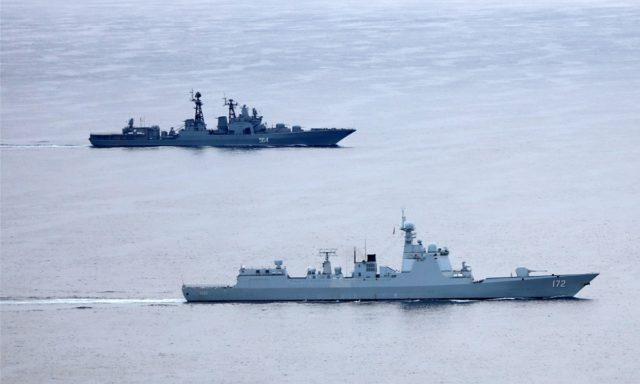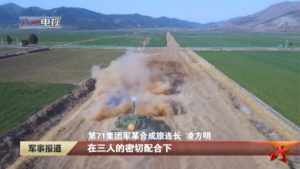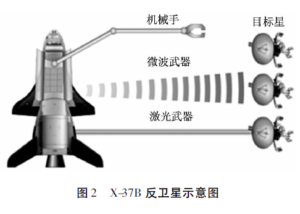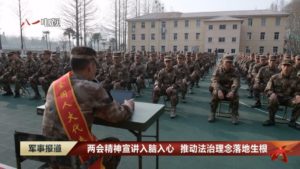
Lessons of Ukraine Raise Doubts about PLA Modernization
Publication: China Brief Volume: 22 Issue: 7
By:

Introduction
In late 2021, ships from China’s North Sea Fleet conducted “Maritime Joint-2021” (海上联合-2021, Haishang lianhe-2021) with the Russian Pacific fleet, which was a joint naval exercise focused on securing sea lanes of communication. Not only did the exercise, “demonstrate the resolve of two great powers,” according to state media, it was also a chance for each side to observe the operational effectiveness of their counterparts (CCTV-7, October 15, 2021). Like all modern militaries, the Chinese People’s Liberation Army (PLA) is fundamentally a learning organization. Militaries must learn, adapt, and teach tactics and doctrine in a constant cycle. China’s military modernization and doctrinal reform have been largely informed by U.S. campaigns, which PLA observers have carefully parsed, including the Iraq, Afghanistan and Kosovo wars. From these observations, the PLA has embarked on a herculean effort to restructure, reform, retrain, and properly arm its forces. In its own words, joint training is the “bridge” or “ship” for ferrying the PLA to becoming a high-quality force. [1] For the past two decades, the PLA has been a ship being rebuilt while also underway. Now in the shadow of a Russian invasion of Ukraine that has seen a large and similarly reformed Soviet-style military largely fail to attain its primary objectives, the PLA must face the possibility that its own reforms are riddled with hidden weaknesses and fundamental faults.
For the PLA, one worrying observation must be that Russia has failed to conduct effective World War II-style combined arms operations, much less modern joint operations, with land, sea, air, cyber, and space forces operating in a coordinated fashion. PLA reforms have transformed an army once incapable of effectively coordinating ground fires in the 1979 Sino-Vietnamese War to an inter-service joint warfighting force. [2] One restricted-access doctrinal treatise defines the purpose of these joint reforms as: “to counter preparations by ‘Taiwan independence’ [elements] for military conflict and to directly link responses with specific training—this is the fundamental mission of integrated [joint] training.” [3] The quality of PLA joint capabilities has a direct bearing on the Chinese Communist Party’s (CCP) political objectives toward Taiwan, much like Russia’s military reforms since 2008 have been part of the Kremlin’s strategic calculus toward Ukraine. Whether the People’s Republic of China (PRC) stumbles into a debacle of their own making may depend on the lessons drawn from Russia’s invasion of Ukraine.
Command Models and Unit Initiative
For modern militaries, operational agility requires devolving authority of command to lower echelon units in order to foster battlefield initiative when opportunities arise. A hierarchical command structure—over-reliant on the direct involvement of general officers—is not only detrimental to maintaining momentum, but those officers can also quickly become nodes of vulnerability in the fog of war. At least seven such Russian generals have been killed in the opening weeks of the invasion (Japan Times, March 26). Empowering unit commanders would reduce the need to personally involve generals in frontline maneuvers. The restructuring of PLA brigade and division units has been a hallmark of PRC military modernization, including the creation of “combined battalions” (合成营, hecheng ying) and “combined brigades” (合成旅, hecheng lü), for conducting combined arms operations (81.cn, March 20, 2020). These restructured units are similar to Russia’s battalion tactical groups (BTGs), which were designed to be “the primary fighting unit of the country’s army” in 2012, with approximately 100 of the 170 total BTGs committed to the Ukraine war (Financial Times, March 16). In training exercises, PLA unit commanders are shown issuing commands to coordinate with other elements within their echelon, but are not generally reported as operating under degraded conditions or beyond the unit’s organic assets (81.cn, March 21). In contrast to Russia, opposing forces exercises have become the norm in annual examination exercises for PLA ground forces and the PLA has expanded its non-commissioned officer (NCO) corps. [4] Russia’s reliance on conscripts and lack of progress in building a professional NCO corps may have contributed to its initial failures in Ukraine (Congressional Research Service, July 20, 2020). Even as PLA exercise directors have imposed more complex exercise conditions on units, the scope of decision-making power for individual commanders remains limited and coordination with other units still depends on upper-echelon authorities.
Figure 1. Combined armored brigade training depicted in Military Report.

Russia’s loss of so many generals also exposes a particular weakness of the PLA’s own joint command model. Generals killed in Ukraine include those of the deputy commander and chief-of-staff grade, which is the grade that exercises joint operations coordination duties in the PLA (China Brief, October 5, 2012). A brigade or division-sized unit may have only three or four officers of sufficient rank to perform these critical duties. If PLA units in wartime suffered such attrition among command staff, despite the increasing reliance on automation and information networks, such losses might result in retaining the technical means for joint coordination, but lacking the authorities to effectively task and respond to joint requirements.
Hidden Capabilities, Crouching Stratagems
From enthusiast magazines to academic journals, widespread suspicion exists in China that the U.S. military possesses certain undisclosed capabilities in the space, cyber, and electromagnetic domains for which the PLA has no answer. Perhaps the most popular example of this is the U.S. Air Force’s X-37B spaceplane, with suggestions that the vehicles could be platforms for fielding laser, kinetic, or microwave anti-satellite weapons. [5] The uncertain purpose of the spaceplanes has spurred China’s defense industry academies to accelerate their own programs on developing hypersonic vehicles, satellite grabber arms, and other novel capabilities.
Figure 2. Depiction of potential X-37B uses in an academic paper.

PRC defense experts’ suspicions extend to the electronic capabilities of specific U.S. programs. PLA analysts highlight programs like “Netted Emulation of Multi-Element Signature against Integrated Sensors (NEMESIS)” and the “Suter Project System” as examples of advanced electronic warfare systems that may be capable of creating false radar returns, among other uses (Security Internal Reference, November 11, 2019). These anxieties have likely been exacerbated by Russian forces’ inability to achieve air superiority in the Ukraine campaign. Royal United Services Institute (RUSI), a UK think tank, suggested that a “focus on the impressive combat-air equipment modernization conducted by Russia since 2010” had led to overestimations of the performance of the Russian Aerospace Forces in actual combat (RUSI, March 4). In testimony to Congress, Director of the Defense Intelligence Agency Lieutenant General Scott Berrier and Director of the National Security Agency General Paul Nakasone affirmed the importance of diversified intelligence, surveillance, and reconnaissance (ISR) platforms, including “penetrating platforms” in conflict environments (House Armed Services Committee, March 17). The term “penetrating platforms” will have piqued the anxieties of PLA observers, as it refers to stealthy platforms that can operate undetected in contested airspace. In addition to reconnaissance, the abilities of such platforms can be informed by capabilities that PRC defense industry engineers have imagined themselves. In one paper, researchers from the Chinese Academy of Equipment (装备学院, zhuangbei xueyuan) proposed a jamming system relying on in situ platforms to protect a ship by generating false target signals to fool space-based sensors. [6] Other examples involve the spoofing of global navigation satellite signals and commercial satellite communications. [7] Similar research topics appear frequently in Chinese academic journals, suggesting that the potential for advanced electronic warfare capabilities is well appreciated within PLA circles. In a wartime situation, the PLA would likely expect the battlespace to become cluttered and confused due to undisclosed adversary capabilities.
Readiness or Red-ness
This discussion only scratches the surface of what might keep a PLA planner up at night. The emphasis on “red culture” and “red genes”—burnishing the origin mythos of the CCP and PLA—permeates all levels of society, but particularly the military. Devoting such energy to political education hints at the insecurity President Xi Jinping feels about the ideological purity of the armed forces, and by implication, their will to fight in an actual conflict. Early last month, during the “Two Sessions” period, when the National People’s Congress and the Chinese People’s Consultative Conference met, the PLA imposed mandatory study sessions at all levels, which occupied valuable training time (81.cn, March 21). Russian troops have shown pervasive morale and unit cohesion problems, which the CCP must recognize as a military lacking in ideological quality. Perhaps this will lead to doubling down on political education within the PLA, not only further eroding substantive training priorities, but also suggesting that the average “G.I. Zhou” may lack a compelling reason to fight.
Figure 3. A unit receives political education during the “Two Sessions.”

Conclusion
Ultimately, the Russo-Ukrainian war has not only revealed fundamental flaws in Russia’s military, but has also demonstrated the resolve and capabilities of NATO and other democratic nations in supporting one another in times of crisis. This ought to give Xi pause in pursuing his own vision of capturing Taiwan before his tenure as president and general secretary comes to an end. Yet, while these setbacks observed from afar might delay a full-scale amphibious invasion of Taiwan, they might also prompt PLA leadership to accelerate the timetable for a smaller scale conflict. In order to truly test the outcomes of their two decades of technical investments and structural reforms, the Central Military Commission may choose to launch an outlying island seizure, naval blockade, or other limited campaign that could be de-escalated quickly under China’s own concepts of “war control” (战争控制, zhanzheng kongzhi). [8] This raises the stakes for deterrence forces in theater and underscores the imperative to improve the indigenous capabilities of the Taiwanese armed forces. Indo-Pacific forces must be ready to respond to any attempts at military misadventures by another aging authoritarian nursing revanchist dreams of restored imperial glory.
David D. Chen is an independent analyst located in Denver, CO. His areas of focus include PLA doctrine and training, space and cyber warfare, and emerging disruptive technologies.
Notes
[1] Xu Genchu (徐根初), ed., The Science of Joint Training. Military Science Press (军事科学出版社). Beijing, China: 2006, p. 71.
[2] Edward C. O’Dowd. Chinese Military Strategy in the Third Indochina War: The Last Maoist War. Routledge, New York, NY: 2007, p. 87.
[3] Liu Weiguo (刘卫国), ed., Research on Integrated Training (一体化训练研究). PLA Press (解放军出版社). Beijing, China: 2005, p. 11.
[4] Dennis J. Blasko. “PLA Conscript and Noncomissioned Officer Individual Training,” in The “People” in the PLA: Recruitment, Training, and Education in China’s Military. Roy Kamphausen, Andrew Scobell, and Travis Tanner, eds., Strategic Studies Institute. Carlisle, PA: 2008, p. 100.
[5] Ren Sanhai, et al. “On Development of X-37B Program and Its Application Mode.” Winged Missiles (飞航导弹). December 1, 2014, pp. 3-8.
[6] Ruan Hang (阮航), et al., “Evaluation of Deception Jamming Effect on Tri-Satellite TDOA Location System (三星时差定位系统欺骗干扰效能评估).” Modern Defense Technology (现代防御技术). June 2013, Vol. 41, No. 3, pp. 18-23.
[7] See Zhao Haiyan, Cheng Pengjun, Shi Yingchun, “Introduction of Key Technologies in LEO Satellites Communications and EM Threat,” Aerospace Electronic Warfare, March 2004; Cheng Lirui, Zhang Shunjian, Zeng Fangling, “A Study on Optimized Deployment of Satellite Navigation Jammers,” Fire Control & Command Control, July 2016.
[8] Lonnie D. Henley. “Chinese Concepts of Escalation Management,” in Shaping China’s Security Environment: The Role of the People’s Liberation Army. Andrew Scobell and Larry M. Wortzel, eds., Strategic Studies Institute. Carlisle, PA: 2006, pp. 82.




